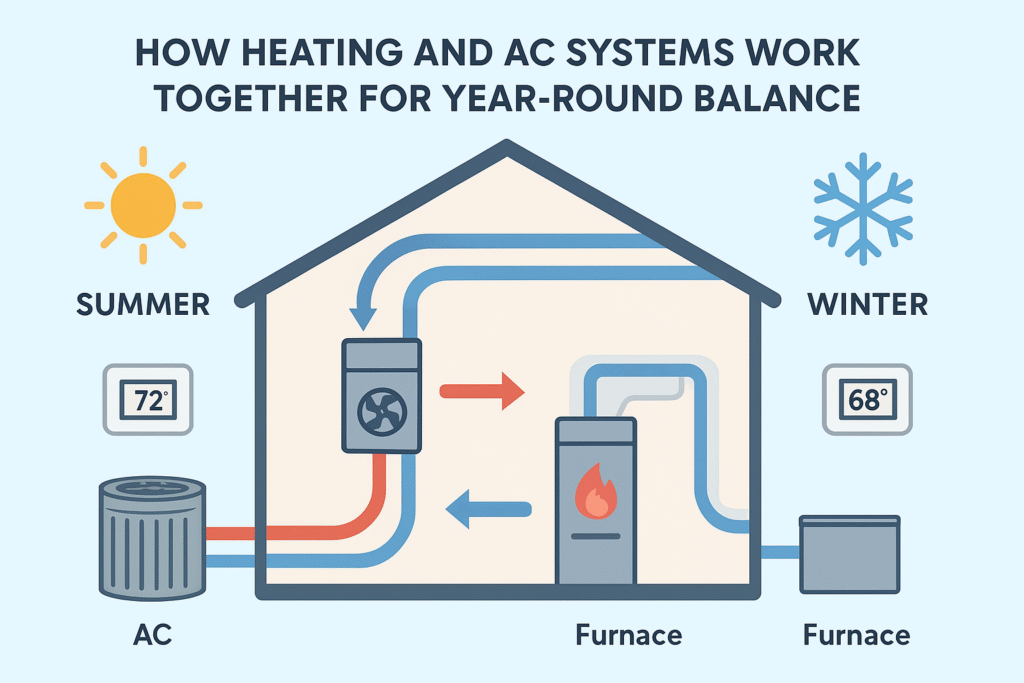Comfort inside a home is not just about staying warm in the winter or cool in the summer—it’s about maintaining steady indoor conditions throughout every season. Heating and air conditioning systems are often thought of as separate units with different purposes, but in reality, they work together as part of a single climate control system. The goal of both systems is balance, helping homeowners maintain comfortable temperatures, consistent airflow, and healthy air quality year-round. When they operate in harmony, heating and cooling systems support energy efficiency, prevent strain on equipment, and improve overall comfort. Understanding how both systems are connected gives homeowners greater control over their indoor environment and allows them to make smarter decisions about maintenance, upgrades, and usage. Heating and AC do not compete—they complement each other to maintain stability regardless of the weather. From thermostats and ductwork to air filtration and humidity control, every part of the system plays a role in creating a comfortable, balanced home.
Shared Components, Shared Performance
One of the most critical ways heating and AC systems work together is through shared components that help deliver air throughout the home. Most central HVAC systems use the same ductwork, blower motor, air handler, and thermostat for both heating and cooling. This means that even though the furnace and air conditioner serve opposite functions, they rely on the same infrastructure. When one system is poorly maintained, it negatively affects the other. For example, if the ductwork is leaking or clogged, both heating and cooling performance suffer, leading to uneven temperatures, higher energy use, and unnecessary strain on the system. The thermostat also plays a key role in maintaining year-round balance by controlling both heating and cooling cycles with precision. Modern programmable and smart thermostats can adjust temperatures automatically based on time of day or usage patterns, helping the two systems alternate smoothly between functions. This shared structure improves consistency and convenience. Working with professionals such as Veterans Heating and Cooling ensures that both systems are installed and maintained with the entire HVAC system in mind, rather than treating them as separate units. By focusing on the whole system, homeowners achieve better performance, longer equipment life, and greater energy savings year-round.
Seasonal Transitions and Energy Efficiency
Heating and AC systems function differently depending on the season, but they rely on each other to create smooth transitions between temperature extremes. During spring and fall, when outdoor temperatures are mild, the HVAC system may switch between heating and cooling within short periods. If the systems are unbalanced or one is outdated, constant switching can lead to inefficiency and wear. A properly maintained system with accurate thermostat calibration ensures seamless seasonal transitions without excessive cycling. Energy efficiency also improves when both heating and cooling components work together. For instance, proper insulation supports both systems by keeping warm air inside during winter and cool air during summer. Similarly, sealing air leaks, maintaining ductwork, and ensuring adequate airflow help both the furnace and the air conditioner run more efficiently. In addition, heat pumps are a great example of systems that combine heating and cooling in a single unit. They can extract heat from the outside air during winter and reverse the cycle during summer, providing an all-in-one solution for year-round balance. By optimizing how both systems function seasonally, homeowners can enjoy lower energy bills and more consistent comfort without overworking either unit.
Humidity Control and Air Quality Balance
Heating and cooling systems also work together to manage humidity and indoor air quality—two critical factors in long-term comfort. In the winter, heating systems tend to dry out the air, leading to low humidity that can cause dry skin, irritated sinuses, and static electricity. To counteract this, many HVAC systems include humidifiers that add moisture to the air before it circulates through the home. In the summer, air conditioning naturally removes moisture from the air as it cools, preventing high humidity that can lead to mold growth, musty odors, and discomfort. When both systems are properly balanced, they maintain an ideal humidity range of 40% to 50%, which supports health and comfort year-round. Air quality is also affected by how these systems interact. Both heating and cooling rely on air filters to remove dust, pollen, and contaminants. If filters are dirty or ducts are clogged, both systems suffer, distributing pollutants throughout the home. Keeping filters clean and ducts maintained improves the performance of both systems and ensures healthier air. Ventilation also plays a role—coordinating heating and cooling with fresh air exchange prevents stale indoor air from building up. When the HVAC system works as a whole, homeowners enjoy clean, balanced air year-round.
Maintenance and Longevity for System Harmony
To keep heating and air conditioning systems working together effectively, regular maintenance is essential. Even though each unit operates differently, both rely on smooth airflow, clean components, and accurate control settings. Routine maintenance helps identify problems early, such as worn-out parts, refrigerant issues, or airflow restrictions that can affect both heating and cooling. Neglecting one system can strain the other. For example, if the AC coil is dirty, airflow becomes restricted, forcing the blower motor to work harder and impacting heating performance as seasons change. Likewise, if the furnace is not tuned correctly, excess heat or poor air circulation can damage shared components, such as the blower or ducts. Preventive maintenance keeps both systems running smoothly and prevents sudden breakdowns. Homeowners should schedule inspections twice a year—once before summer and once before winter—so that each system is prepared for peak use. Regular service not only improves performance but also extends the lifespan of the entire HVAC system. When heating and cooling systems are treated as interconnected rather than separate, they work together more efficiently, deliver consistent comfort, and provide long-term value.
Read More: https://acubi.us/the-importance-of-using-high-quality-paint-in-professional-painting-services/
Year-Round Comfort Through System Balance
Heating and air conditioning systems may function differently, but their true power lies in how they work together to maintain year-round balance in modern homes. They share components, rely on consistent airflow, and operate under the same controls, making them part of a single, unified system. By coordinating seasonal performance, managing humidity, and improving energy efficiency, heating and cooling systems create a stable indoor environment that supports health, comfort, and convenience. Proper maintenance ensures both systems run smoothly, avoiding strain and extending their lifespan. When homeowners understand the connection between heating and cooling, they make more intelligent decisions about upgrades, repairs, and overall system care. The result is a home that stays warm in winter, cool in summer, and comfortable throughout every transition. A well-balanced HVAC system is more than equipment—it’s the foundation of a relaxed and efficient living space. When heating and cooling work together, everyday life becomes easier, healthier, and more enjoyable year-round.



